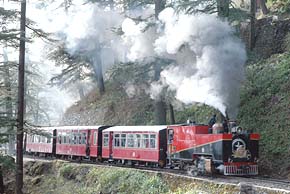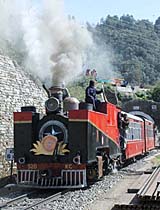 A lot has been said about the historic Kalka-Shimla rail, which is often described as an engineering marvel, but the popularity of this track has in a way shadowed another heritage rail-line that runs across the astonishingly breathtaking Kangra valley – the 164 km Pathankot-Jogindernagar rail track. This train may not lead you to the ‘Queen of the hills’, but its meandering route through a kaleidoscope of contrasting landscapes of hills and valleys makes it one of the most memorable journeys for anyone visiting India. Not just that, the train also has political and industrial significance considering that the rail line was laid down by the British to transport material for the Jogindernagar power project and that at one point it was dismantled and then revived again.
A lot has been said about the historic Kalka-Shimla rail, which is often described as an engineering marvel, but the popularity of this track has in a way shadowed another heritage rail-line that runs across the astonishingly breathtaking Kangra valley – the 164 km Pathankot-Jogindernagar rail track. This train may not lead you to the ‘Queen of the hills’, but its meandering route through a kaleidoscope of contrasting landscapes of hills and valleys makes it one of the most memorable journeys for anyone visiting India. Not just that, the train also has political and industrial significance considering that the rail line was laid down by the British to transport material for the Jogindernagar power project and that at one point it was dismantled and then revived again.
Built in 1929 for carrying raw material to the Shannan Power House at Jogindernagar, the railway runs almost parallel to the Dhauladhars. It connects 32 stations towns such as Jawanwala Shehr, Nagaota Surian, Jwalamukhi Road, Kangra, Nagrota, Baijnath Paprola and Jogindernagar. The Pathankot-Nagrota section of Kangra Valley Railway (110km) was built by the State agency and was managed by Eastern Punjab Railway till the formation of Northern Railway. The Nagrota-Jogindernagar section (56km) was dismantled in 1942. However, in October 1976, this section was reopened on slightly altered alignment.
 Â Â
   Â
 
The ruling gradient on Pathankot-Nagrota section in 1 in 40 but thereafter 1 in 25 on Nagrota-Jogindernagar section. The loco shed at Pathankot caters for this hill line, which climbs almost 1220m at the final terminus. Two superheated class S engines were the first ones to work on KVR and later they were joined by ZF/ZF-1 classes of engines. The line has just two tunnels, one of which is only 250 feet and the other 1,000 feet in length. The traveler must remember that through the total distance of 164 km, instead of boring the way through the mountains, the railway line has skillfully avoided running head first into the hillside. Certainly the scenery through which the train passes is ample compensation for the extra distance covered as compared to getting there by road. The most picturesque parts of the valley are exposed to the view – the stretch of 18 miles from Mangwal to Kangra, for example, lies through country unsurpassed for its majestic grandeur with the majestic Ban Ganga gorge and the deep Kangra chasm as two piece de resistance. As one approaches Palampur, the background of snowy chain peaks, is barely ten miles away. From here onwards, the line runs parallel to the Dhauladhar range and much nearer to it than any other railways in India that ever comes so close to the eternal snows.
Just before Baijnath, the line enters a stretch of country far superior to the journey by road. Here, the train threads its way among the pines of the Bhir gorge. This stretch between Baijnath and Jogindernagar is the steepest. Over here the train moves at a snail’s pace till it reaches the highest point on the track at Ahju. Not far from here are the popular Para-Gliding and Hang-Gliding sites of Bir and Billing. As the train approaches Jogindernagar, the white mountains gradually begin fading away. The Kangra valley railway is ample proof of how a railway line can exist in harmony with nature, without destroying the grandeur of the mountain, and at the same time, revealing to the traveler, an enchanted fairyland.With inputs from:
http://www.northrail.org
http://www.hill-stations-india.com
Another article ablout Railways on myHimachal

